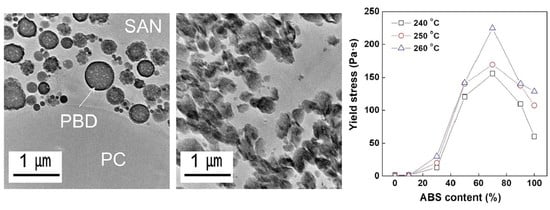Rheological Investigation of Relaxation Behavior of Polycarbonate/Acrylonitrile-Butadiene-Styrene Blends
Abstract
1. Introduction
2. Materials and Methods
2.1. Materials
2.2. Physical Property Measurement
3. Results and Discussion
4. Conclusions
Supplementary Materials
Author Contributions
Funding
Acknowledgments
Conflicts of Interest
References
- Wong, A.C.-Y. Polycarbonate Effects on Selected Mechanical Properties of Polycarbonate/Acrylonitrile-Butadiene-Styrene (PC/ABS) Binary Blending Systems. Polym. Plast. Technol. Eng. 2003, 42, 171–180. [Google Scholar] [CrossRef]
- Krache, R.; Debbah, I. Some Mechanical and Thermal Properties of PC/ABS Blends. Mater. Sci. Appl. 2011, 2, 404–410. [Google Scholar] [CrossRef]
- Ishikawa, M. Stability of plastic deformation and toughness of polycarbonate blended with poly(acrylonitrile-butadiene-styrene) copolymer. Polymer 1995, 36, 2203–2210. [Google Scholar] [CrossRef]
- Yang, J.; Wang, C.-X.; Yu, Z.-S.; Li, Y.; Yang, K.-K.; Wang, Y.-Z. Impact behavior and fracture morphology of acrylonitrile–butadiene–styrene resins toughened by linear random styrene–isoprene–butadiene rubber. J. Appl. Polym. Sci. 2011, 121, 2458–2466. [Google Scholar] [CrossRef]
- Kurauchi, T.; Ohta, T. Energy absorption in blends of polycarbonate with ABS and SAN. J. Mater. Sci. 1984, 19, 1699–1709. [Google Scholar] [CrossRef]
- Min, S. Chain Structure and Mechanical Property in Polyestercarbonates. Ph.D. Thesis, Seoul National University, Seoul, Korea, August 2001. [Google Scholar]
- Kim, H.; Lee, D.-S.; Lim, J.-S.; Lyu, M.-Y. A Study on the Variations of Impact Strength of Plastics for Various Thicknesses and Notch Formation. Polym. Korea 2011, 36, 59–64. [Google Scholar] [CrossRef]
- Wu, J.-S.; Shen, S.-C.; Chang, F.-C. Effect of polycarbonate molecular weight on polymer blends of polycarbonate and ABS. J. Appl. Polym. Sci. 1993, 50, 1379–1389. [Google Scholar] [CrossRef]
- Nigam, I.; Nigam, D.; Mathur, G.N. Effect of Rubber Content of ABS on Properties of PC/ABS Blends. I. Rheological, Mechanical, and Thermal Properties. Polym. Plast. Technol. Eng. 2005, 44, 815–832. [Google Scholar] [CrossRef]
- Choi, H.J.; Park, S.H.; Kim, J.K.; Jun, J.I. Effects of acrylonitrile content on PC/ABS alloy systems with a flame retardant. J. Appl. Polym. Sci. 2000, 75, 417–423. [Google Scholar] [CrossRef]
- Aoki, Y.; Nakayama, K. Dynamic Viscoelastic Properties of ABS Polymers in the Molten State IV. Effect of Rubber Particle Size. Polym. J. 1982, 14, 951–958. [Google Scholar] [CrossRef]
- Aoki, Y. Dynamic viscoelastic properties of ABS polymers in the molten state. 5. Effect of grafting degree. Macromolecules 1987, 20, 2208–2213. [Google Scholar] [CrossRef]
- Aoki, Y. Rheological properties of ABS polymer melts having a good dispersion of rubber particles. J. Non-Newton. Fluid Mech. 1986, 22, 91–99. [Google Scholar] [CrossRef]
- Hasegawa, R.; Aoki, Y.; Doi, M. Optimum Graft Density for Dispersing Particles in Polymer Melts. Macromolecules 1996, 29, 6656–6662. [Google Scholar] [CrossRef]
- Lombardo, B.S.; Keskkula, H.; Paul, D.R. Influence of ABS type on morphology and mechanical properties of PC/ABS blends. J. Appl. Polym. Sci. 1994, 54, 1697–1720. [Google Scholar] [CrossRef]
- Inberg, J.P.F.; Gaymans, R.J. Co-continuous polycarbonate/ABS blends. Polymer 2002, 43, 2425–2434. [Google Scholar] [CrossRef]
- Lee, M.-P.; Hiltner, A.; Baer, E. Formation and break-up of a bead-and-string structure during injection moulding of a polycarbonate/acrylonitrile-butadiene-styrene blend. Polymer 1992, 33, 675–684. [Google Scholar] [CrossRef]
- Lee, M.-P.; Hiltner, A.; Baer, E. Phase morphology of injection-moulded polycarbonate/acrylonitrile-butadiene-styrene blends. Polymer 1992, 33, 685–697. [Google Scholar] [CrossRef]
- Chaudhry, B.I.; Hage, E.; Pessan, L.A. Effects of processing conditions on the phase morphology of PC/ABS polymer blends. J. Appl. Polym. Sci. 1998, 67, 1605–1613. [Google Scholar] [CrossRef]
- Bärwinkel, S.; Seidel, A.; Hobeika, S.; Hufen, R.; Mörl, M.; Altstädt, V. Morphology Formation in PC/ABS Blends during Thermal Processing and the Effect of the Viscosity Ratio of Blend Partners. Materials 2016, 9, 659. [Google Scholar] [CrossRef]
- Jung, H.J.; Son, Y.; Park, O.O. Influence of acrylonitrile content in styrene-acrylonitrile copolymer on the phase morphology and interfacial tension in blends of polycarbonate/styrene-acrylonitrile copolymer. Macromol. Res. 2014, 22, 146–153. [Google Scholar] [CrossRef]
- Eom, Y.; Kim, B.C. The effect of dimethylsulfoxide on the dissociation process of physical complexes of polyacrylonitrile in N,N-dimethylformamide. Polym. Int. 2017, 66, 1099–1106. [Google Scholar] [CrossRef]
- Eom, Y.; Kim, B.C. Solubility parameter-based analysis of polyacrylonitrile solutions in N,N-dimethyl formamide and dimethyl sulfoxide. Polymer 2014, 55, 2570–2577. [Google Scholar] [CrossRef]
- Eom, Y.; Kim, T.W.; Kim, B.C. The Respective Roles of Metal Salts in The Dissolution Process of Poly(1-oxotrimethylene) in Their Aqueous Solutions. Macromol. Res. 2016, 24, 450–456. [Google Scholar] [CrossRef]
- Eom, Y.; Kim, C.; Kim, B.C. Effects of physical association through nitrile groups on the MWD-dependent viscosity behavior of polyacrylonitrile solutions. Macromol. Res. 2017, 25, 262–269. [Google Scholar] [CrossRef]
- Chae, D.W.; Jang, H.B.; Kim, B.C. Investigation of phase stability of poly(1-oxotrimethylene)-dissolved aqueous solutions containing ZnCl2/CaCl2/LiCl: Influence of boric acid introduction and aging time. Korea-Aust. Rheol. J. 2018, 30, 41–46. [Google Scholar] [CrossRef]
- Aoki, Y.; Hatano, A.; Tanaka, T.; Watanabe, H. Nonlinear Stress Relaxation of ABS Polymers in the Molten State. Macromolecules 2001, 34, 3100–3107. [Google Scholar] [CrossRef]
- Boronat, T.; Segui, V.J.; Peydro, M.A.; Reig, M.J. Influence of temperature and shear rate on the rheology and processability of reprocessed ABS in injection molding process. J. Mater. Process. Technol. 2009, 209, 2735–2745. [Google Scholar] [CrossRef]
- Malana, M.A.; Zohra, R.; Khan, M.S. Rheological characterization of novel physically crosslinked terpolymeric hydrogels at different temperatures. Korea-Aust. Rheol. J. 2005, 17, 155–162. [Google Scholar] [CrossRef]
- Balakrishnan, S.; Neelakantan, N.R.; Saheb, D.N.; Jog, J.P. Rheological and morphological behaviour of blends of polycarbonate with unmodified and maleic anhydride grafted ABS. Polymer 1998, 39, 5765–5771. [Google Scholar] [CrossRef]
- Babbar, I.; Mathur, G.N. Rheological properties of blends of polycarbonate with poly(acrylonitrile-butadiene-styrene). Polymer 1994, 35, 2631–2635. [Google Scholar] [CrossRef]
- Liu, B.; Wan, C.; Shou, W.; Zhang, Y.; Su, Y.; Ji, J. Rheological Properties and Morphology of PC/AES Blends. J. Macromol. Sci. B 2006, 45, 987–1004. [Google Scholar] [CrossRef]
- Liu, B.; Zhang, Y.; Wan, C.; Zhang, Y.; Su, Y.; Ji, J. Microstructure, Interfacial Interactions, and Rheological Properties of PC/AES/Montmorillonite Composites. J. Macromol. Sci. B 2006, 45, 1159–1169. [Google Scholar] [CrossRef]
- Hong, J.H.; Song, K.H.; Lee, H.G.; Han, M.S.; Kim, Y.H.; Kim, W.N. Morphological, mechanical and rheological properties of poly(acrylonitrile-butadienestyrene)/polycarbonate/poly(ε-caprolactone) ternary blends. Macromol. Res. 2007, 15, 520–526. [Google Scholar] [CrossRef]
- Rostami, A.; Masoomi, M.; Fayazi, M.J.; Vahdati, M. Role of multiwalled carbon nanotubes (MWCNTs) on rheological, thermal and electrical properties of PC/ABS blend. RSC Adv. 2015, 5, 32880–32890. [Google Scholar] [CrossRef]
- Khan, M.M.K.; Liang, R.F.; Gupta, R.K.; Agarwal, S. Rheological and mechanical properties of ABS/PC blends. Korea-Aust. Rheol. J. 2005, 17, 1–7. Available online: https://www.cheric.org/PDF/KARJ/KR17/KR17-1-0001.pdf (accessed on 11 August 2020).
- Martin, P.; Carreau, P.J.; Favis, B.D.; Jérôme, R. Investigating the morphology/rheology interrelationships in immiscible polymer blends. J. Rheol. 2000, 44, 569–583. [Google Scholar] [CrossRef][Green Version]
- Kitade, S.; Ichikawa, A.; Imura, N.; Takahashi, Y.; Noda, I. Rheological properties and domain structures of immiscible polymer blends under steady and oscillatory shear flows. J. Rheol. 1997, 41, 1039–1060. [Google Scholar] [CrossRef]
- Wang, H.; Yang, X.; Fu, Z.; Zhao, X.; Li, Y.; Li, J. Rheology of nanosilica-compatibilized immiscible polymer blends: Formation of a “heterogeneous network” facilitated by interfacially anchored hybrid nanosilica. Macromolecules 2017, 50, 9494–9506. [Google Scholar] [CrossRef]
- Hyun, K.; Wilhelm, M.; Klein, C.O.; Cho, K.S.; Nam, J.G.; Ahn, K.H.; Lee, S.J.; Ewoldt, R.H.; McKinley, G.H. A review of nonlinear oscillatory shear tests: Analysis and application of large amplitude oscillatory shear (LAOS). Prog. Polym. Sci. 2011, 36, 1697–1753. [Google Scholar] [CrossRef]
- Eom, Y.; Kim, B.C. Effects of chain conformation on the viscoelastic properties of polyacrylonitrile gels under large amplitude oscillatory shear. Eur. Polym. J. 2016, 85, 341–353. [Google Scholar] [CrossRef]
- Sun, W.; Yang, Y.; Wang, T.; Liu, X.; Wang, C.; Tong, Z. Large amplitude oscillatory shear rheology for nonlinear viscoelasticity in hectorite suspensions containing poly(ethylene glycol). Polymer 2011, 52, 1402–1409. [Google Scholar] [CrossRef]
- Cho, K.S.; Hyun, K.; Ahn, K.H.; Lee, S.J. A geometrical interpretation of large amplitude oscillatory shear response. J. Rheol. 2005, 49, 747–758. [Google Scholar] [CrossRef]
- Carmona, J.A.; Ramírez, P.; Calero, N.; Muñoz, J. Large amplitude oscillatory shear of xanthan gum solutions. Effect of sodium chloride (NaCl) concentration. J. Food Eng. 2014, 126, 165–172. [Google Scholar] [CrossRef]
- Ewoldt, R.H.; Hosoi, A.E.; McKinley, G.H. New measures for characterizing nonlinear viscoelasticity in large amplitude oscillatory shear. J. Rheol. 2008, 52, 1427–1458. [Google Scholar] [CrossRef]
- Ewoldt, R.H.; Clasen, C.; Hosoi, A.E.; McKinley, G.H. Rheological fingerprinting of gastropod pedal mucus and synthetic complex fluids for biomimicking adhesive locomotion. Soft Matter 2007, 3, 634. [Google Scholar] [CrossRef]
- Chae, D.W.; Lim, J.H.; Seo, J.S.; Kim, B.C. Variation of physical properties of nylon-66/clay nanocomposites with preparation conditions. Korea-Aust. Rheol. J. 2012, 24, 45–52. [Google Scholar] [CrossRef]
- Chae, D.W.; Nam, Y.; An, S.G.; Cho, C.G.; Lee, E.J.; Kim, B.C. Effects of molecular architecture on the rheological and physical properties of polycaprolactone. Korea-Aust. Rheol. J. 2017, 29, 129–135. [Google Scholar] [CrossRef]
- Bae, W.-S.; Lee, S.; Kim, B.C. Effect of shear condition on the thermal stabilization of ethylene–propylene–carbon monoxide terpolymer. Polym. Degrad. Stabil. 2014, 105, 160–165. [Google Scholar] [CrossRef]
- Memon, N.A. Rheological properties and the interface in polycarbonate/impact modifier blends: Effect of modifier shell molecular weight. J. Polym. Sci. Part B Polym. Phys. 1998, 36, 1095–1105. [Google Scholar] [CrossRef]
- Chun, J.-H.; Maeng, K.-S.; Suh, K.S. Miscibility and synergistic effect of impact strength in polycarbonate/ABS blends. J. Mater. Sci. 1991, 26, 5347–5352. [Google Scholar] [CrossRef]
- Aid, S.; Eddhahak, A.; Ortega, Z.; Froelich, D.; Tcharkhtchi, A. Experimental study of the miscibility of ABS/PC polymer blends and investigation of the processing effect. J. Appl. Polym. Sci. 2017, 134, 44975. [Google Scholar] [CrossRef]
- Bae, W.-S.; Kwon, O.J.; Kim, B.C.; Chae, D.W. Effects of multi-walled carbon nanotubes on rheological and physical properties of polyamide-based thermoplastic elastomers. Korea-Aust. Rheol. J. 2012, 24, 221–227. [Google Scholar] [CrossRef]
- Bae, J.; Lee, S.; Kim, B.C.; Cho, H.H.; Chae, D.W. Polyester-based thermoplastic elastomer/MWNT composites: Rheological, thermal, and electrical properties. Fibers Polym. 2013, 14, 729–735. [Google Scholar] [CrossRef]
- Eom, Y.; Jung, D.E.; Hwang, S.S.; Kim, B.C. Characteristic dynamic rheological responses of nematic poly(p-phenylene terephthalamide) and cholesteric hydroxypropyl cellulose phases. Polym. J. 2016, 48, 869–874. [Google Scholar] [CrossRef]

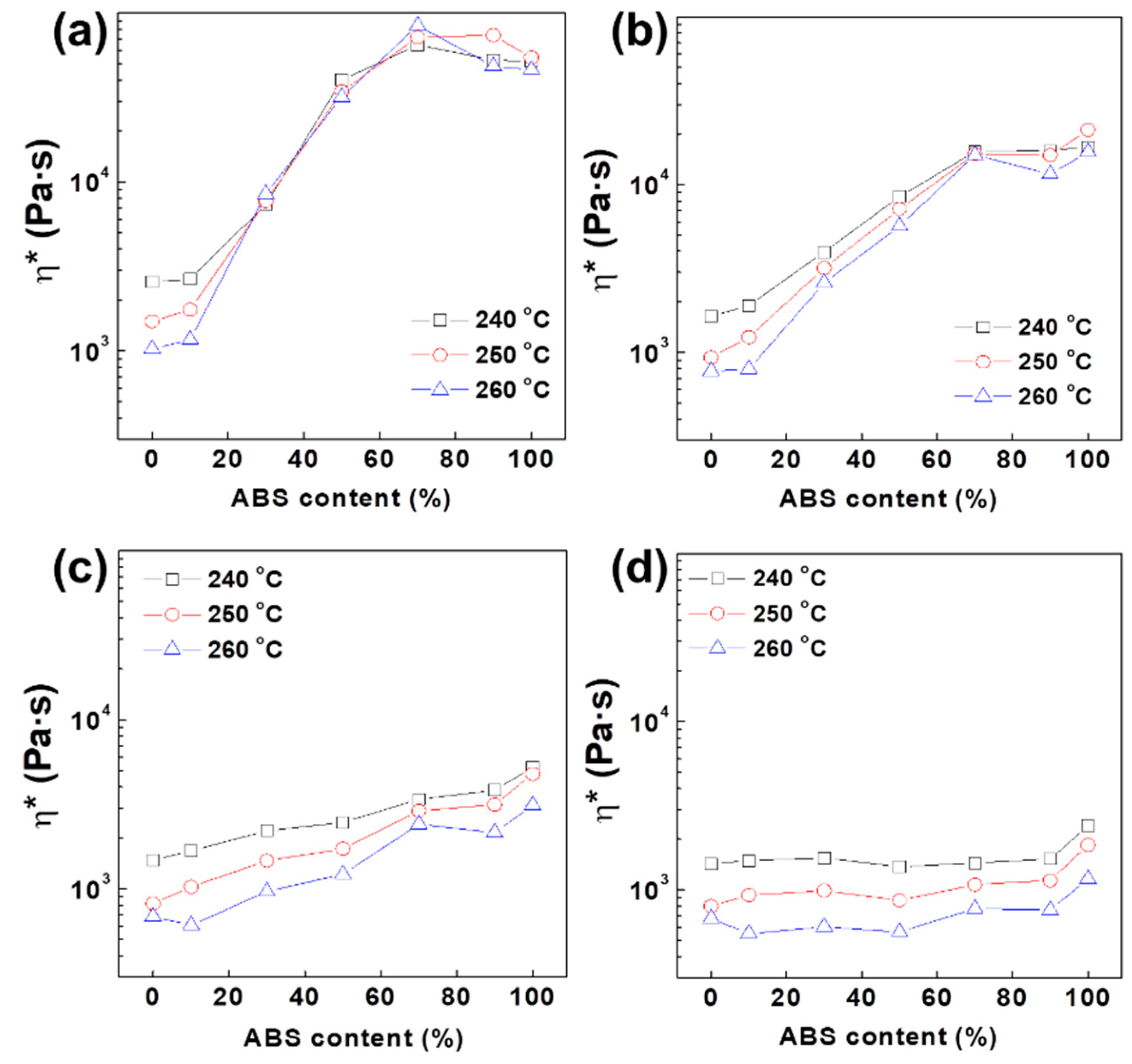

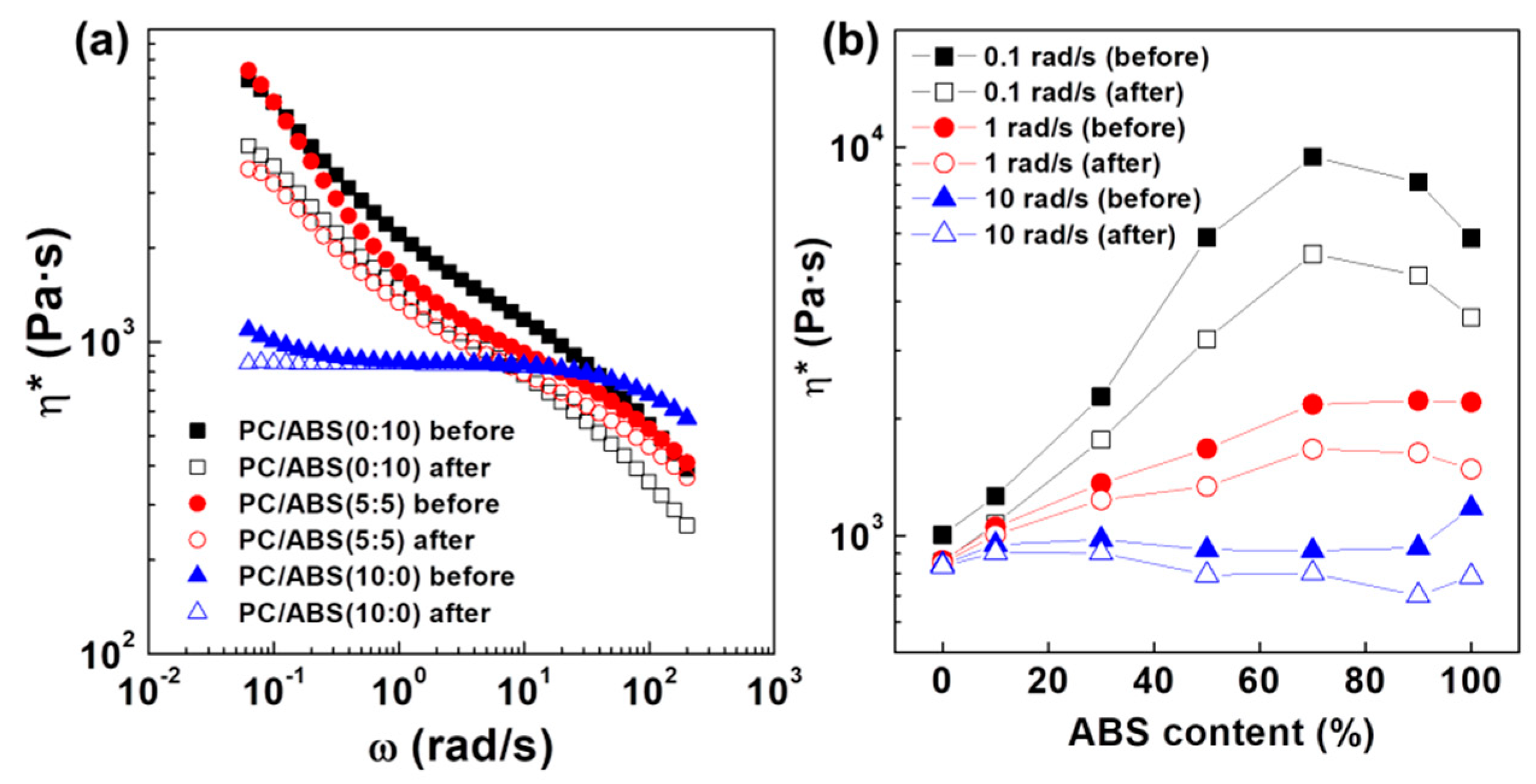
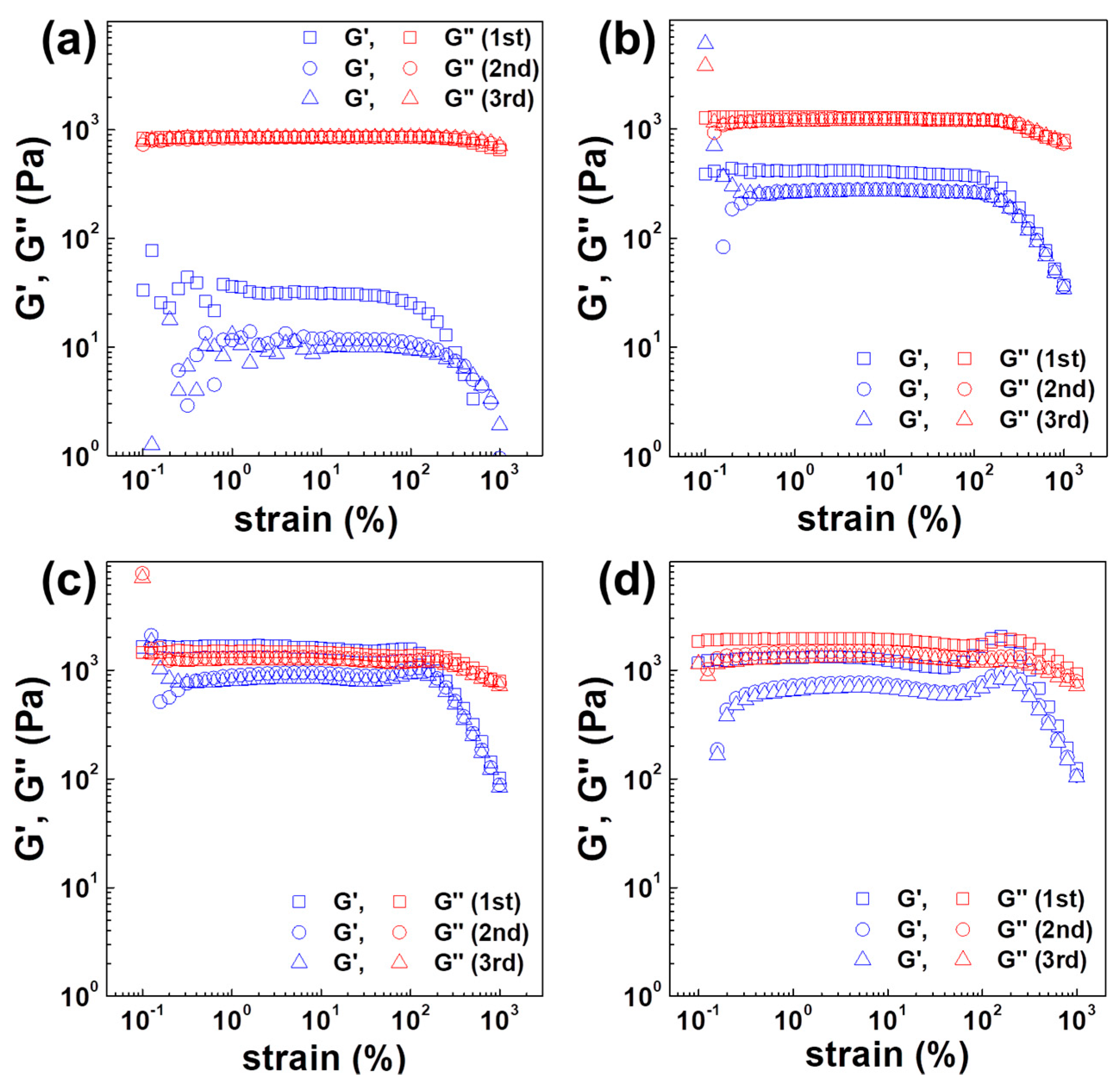
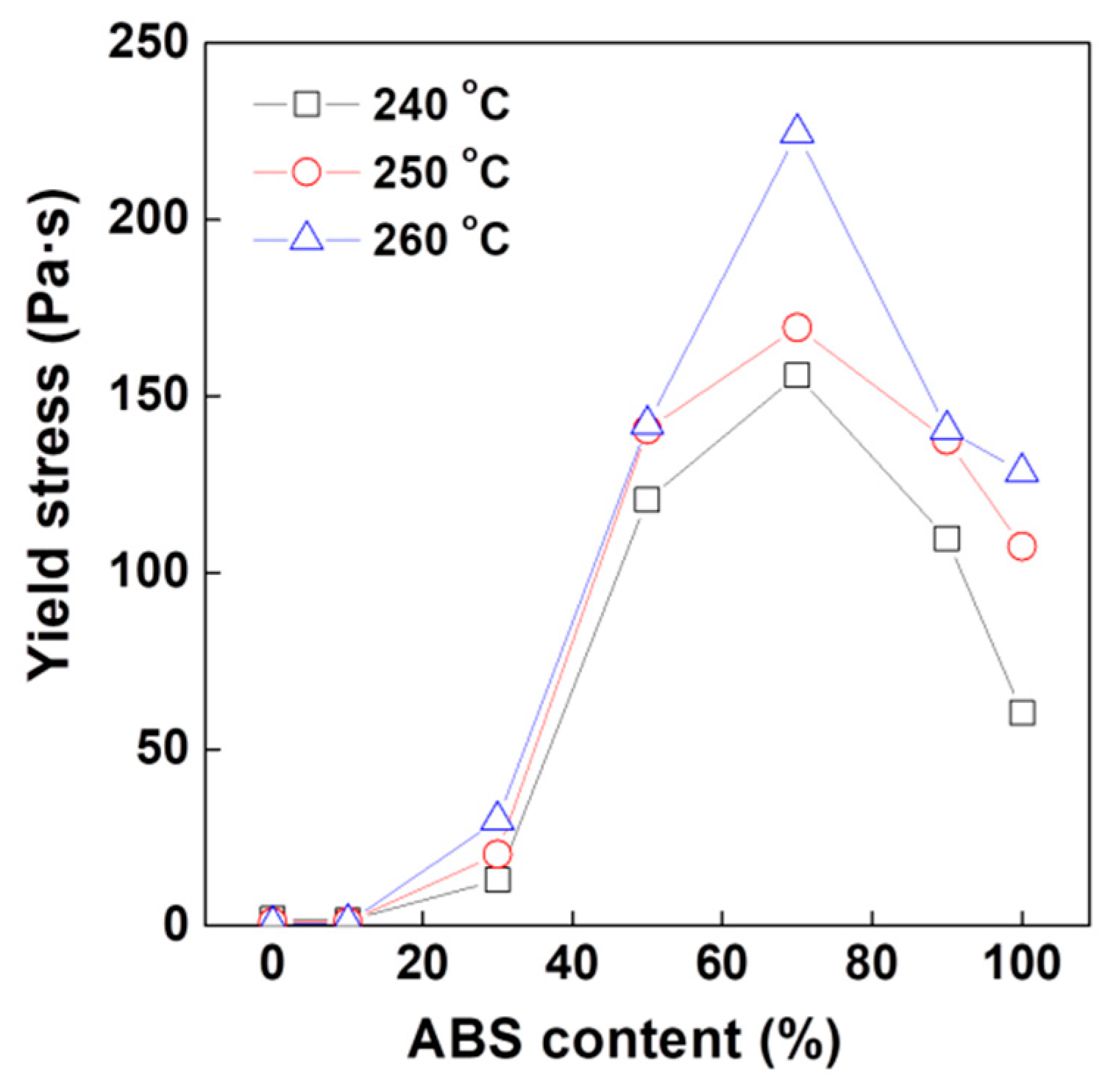

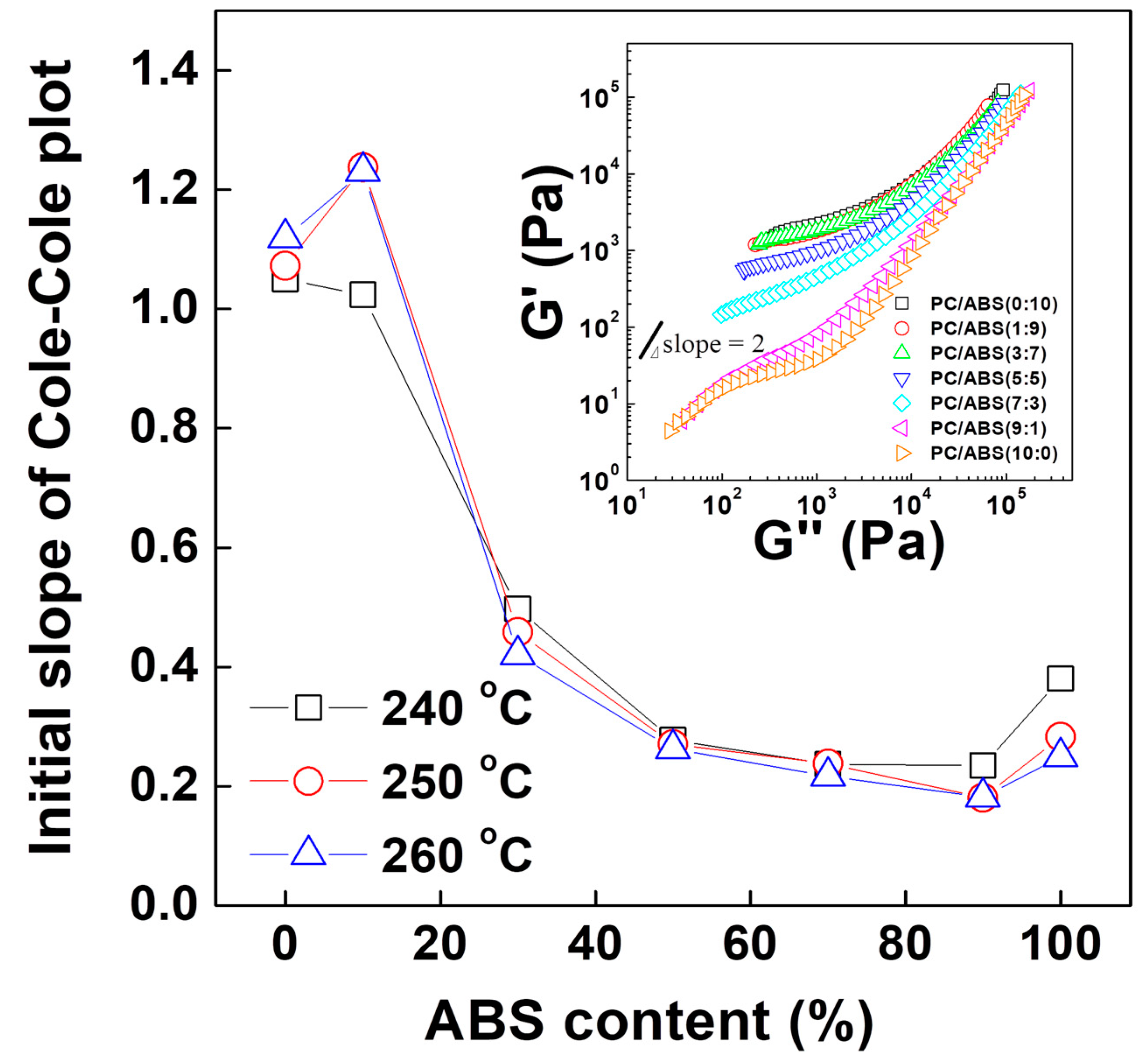
| Blend Ratio (PC:ABS) | 10:0 | 9:1 | 7:3 | 5:5 | 3:7 | 1:9 | 0:10 |
|---|---|---|---|---|---|---|---|
| PC (wt%) | 100 | 90 | 70 | 50 | 30 | 10 | 0 |
| PBD (wt%) | 0 | 4 | 12 | 20 | 28 | 36 | 40 |
| SAN (wt%) | 0 | 6 | 18 | 30 | 42 | 54 | 60 |
| Temp. (°C) | Frequency (rad/s) | Relaxation Time (s) | ||||||
|---|---|---|---|---|---|---|---|---|
| 10:0 | 9:1 | 7:3 | 5:5 | 3:7 | 1:9 | 0:10 | ||
| 240 | 0.1 | 1.52 | 1.45 | 5.73 | 8.91 | 9.41 | 9.30 | 8.60 |
| 1 | 0.04 | 0.078 | 0.31 | 0.56 | 0.7 | 0.71 | 0.6 | |
| 10 | 0.011 | 0.015 | 0.027 | 0.039 | 0.051 | 0.057 | 0.053 | |
| 100 | 0.004 | 0.004 | 0.0048 | 0.0054 | 0.0062 | 0.0068 | 0.007 | |
| 250 | 0.1 | 1.58 | 1.74 | 6.97 | 9.25 | 9.62 | 9.51 | 9.44 |
| 1 | 0.042 | 0.08 | 0.37 | 0.64 | 0.78 | 0.77 | 0.73 | |
| 10 | 0.0073 | 0.012 | 0.027 | 0.041 | 0.055 | 0.06 | 0.057 | |
| 100 | 0.0031 | 0.0032 | 0.0041 | 0.0049 | 0.0058 | 0.0065 | 0.0067 | |
| 260 | 0.1 | 1.07 | 2.06 | 7.85 | 9.41 | 9.75 | 9.65 | 9.59 |
| 1 | 0.037 | 0.1 | 0.46 | 0.7 | 0.84 | 0.79 | 0.77 | |
| 10 | 0.005 | 0.01 | 0.028 | 0.042 | 0.59 | 0.058 | 0.057 | |
| 100 | 0.0025 | 0.0026 | 0.0036 | 0.0044 | 0.0056 | 0.006 | 0.0063 | |
| Temperature (°C) | Initial Slope of Modified Cole-Cole Plot | ||||||
|---|---|---|---|---|---|---|---|
| 10:0 | 9:1 | 7:3 | 5:5 | 3:7 | 1:9 | 0:10 | |
| 240 | 1.05 | 1.02 | 0.50 | 0.28 | 0.24 | 0.23 | 0.38 |
| 250 | 1.07 | 1.24 | 0.46 | 0.27 | 0.24 | 0.18 | 0.28 |
| 260 | 1.12 | 1.23 | 0.42 | 0.26 | 0.22 | 0.18 | 0.25 |
© 2020 by the authors. Licensee MDPI, Basel, Switzerland. This article is an open access article distributed under the terms and conditions of the Creative Commons Attribution (CC BY) license (http://creativecommons.org/licenses/by/4.0/).
Share and Cite
Seo, J.S.; Jeon, H.T.; Han, T.H. Rheological Investigation of Relaxation Behavior of Polycarbonate/Acrylonitrile-Butadiene-Styrene Blends. Polymers 2020, 12, 1916. https://doi.org/10.3390/polym12091916
Seo JS, Jeon HT, Han TH. Rheological Investigation of Relaxation Behavior of Polycarbonate/Acrylonitrile-Butadiene-Styrene Blends. Polymers. 2020; 12(9):1916. https://doi.org/10.3390/polym12091916
Chicago/Turabian StyleSeo, Jae Sik, Ho Tak Jeon, and Tae Hee Han. 2020. "Rheological Investigation of Relaxation Behavior of Polycarbonate/Acrylonitrile-Butadiene-Styrene Blends" Polymers 12, no. 9: 1916. https://doi.org/10.3390/polym12091916
APA StyleSeo, J. S., Jeon, H. T., & Han, T. H. (2020). Rheological Investigation of Relaxation Behavior of Polycarbonate/Acrylonitrile-Butadiene-Styrene Blends. Polymers, 12(9), 1916. https://doi.org/10.3390/polym12091916





